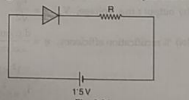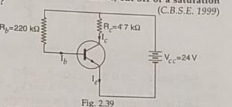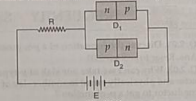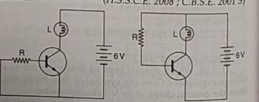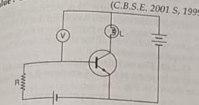EXAMPLE from MODERN PUBLICATION Chapter 26 SEMICONDUCTOR DEVICES for Class 12
| Class 12 | PHYSICS |
| Chapter | SEMICONDUCTOR DEVICES |
| MODERN PUBLICATION | EXAMPLE |
| Medium | English |
| Academic Year | 2023-2024 |
Question 3
Assume that the silicon diode in the circui shown in fig. requires a minimum current of 1mA to be above the knee point (0.7V) of its I-V characteristics. Aslo assume that the voltage across the diode is independent of current above the knee point.
If VB=5V, what should be the maximum value of R so that the voltage is above the knee point?
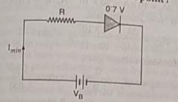 View Solution
View SolutionQuestion 4
Assume that the silicon diode in the circui shown in fig. requires a minimum current of 1mA to be above the knee point (0.7V) of its I-V characteristics. Aslo assume that the voltage across the diode is independent of current above the knee point.
If VB=5V, what should be the value of R to estabilish the current of 5mA in the circuit?
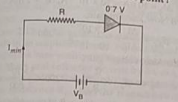 View Solution
View SolutionQuestion 5
Assume that the silicon diode in the circui shown in fig. requires a minimum current of 1mA to be above the knee point (0.7V) of its I-V characteristics. Aslo assume that the voltage across the diode is independent of current above the knee point.
What is the power dissipated in the resistance R and in the diode, when a current of 5mA flows in the circuit at VB=6V?
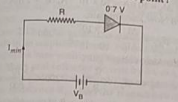 View Solution
View SolutionQuestion 6
Assume that the silicon diode in the circui shown in fig. requires a minimum current of 1mA to be above the knee point (0.7V) of its I-V characteristics. Aslo assume that the voltage across the diode is independent of current above the knee point.
If R=1kΩ, what is the minimum voltageVB required to keep the diode above the knee point?
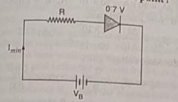 View Solution
View SolutionQuestion 15
In a silicon transistor, the base current is changed by 20μA. This results in a change of 0.02 V in base to emitter voltage and a change of 2mA in the collector current.
This transistor is used as an amplifier in CE configuration with load resistance 5kΩ. What is the voltage gain of the amplifier.View SolutionQuestion 17
A transistor is used in common emitter mode in an amplifier circuit.When a signal of 24 mV (millivolt) is added to base emitter voltage, the base current changes by 32μA (micro ampere) and collector current by 3.6 mA (milli ampere) and the load resistance is 4.8kΩ (kilo ohm). Calculate trans conductance gmView SolutionQuestion 18
A transistor is used in common emitter mode in an amplifier circuit.When a signal of 24 mV (millivolt) is added to base emitter voltage, the base current changes by 32μA (micro ampere) and collector current by 3.6 mA (milli ampere) and the load resistance is 4.8kΩ (kilo ohm). Calculate voltage gain.View SolutionQuestion 24
A n-p-n transistor is connected in common emitter configuration in which collector supply is 9V and the voltage drop across the load resistance of 700Ω connected to the collector circuit is 0.7V. If the current amplification factor alpha is 25/26, determine collector emitter voltage and base current. If the input resistance of the transistor is 100Ω, calculate the voltage gain and the power gain.View SolutionQuestion 25
An amplifier is represented by the circuit shown in Fig. Here ri is the input resistance of the amplifier and the voltage Vi is appearing across it. This voltage is amplified by a factor AV and appears across the load as voltageV0
An external voltage V_(s) is applied at the input terminals of the amplifier via series resistance R_(S). What will be the apparent gain AV(=V0/Vs) of the ampilifier in terms of AV,RSandri.
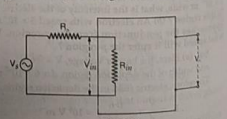 View Solution
View SolutionQuestion 134
In a p-n junction diode, the current I can be expressed as I=I0exp(eV2kBT) where I0 is called the reverse saturation current, V is the voltage across the diode and is positive for forward bias and negative for reverse bias, and I is the current through the diode, kB is the Boltzmann constant (8.6×10−5eVK) and T is the absolute temperature. If for a given diode I0=5×10−12A and T = 300 K, then - What will be the increase in the current if the voltage across the diode is increased from 0.6 V to 0.7 V?View SolutionQuestion 135
In a p-n junction diode, the current I can be expressed as I=I0(exp(eV2kBT)−1) where I_0 is called the reverse saturation current, V is the voltage across the diode and is positive for forward bias and negative for reverse bias, and I is the current through the diode, k_B is th Boltzmann constant (8.6xx 10^ -5 eV/K) and T is the absolute temperature. If for a given diode I_0 = 5 xx 10^ -12 A and T = 300 K, then - What will be the forward current at a forward voltage of 0.6 V?View SolutionQuestion 136
In a p-n junction diode, the current I can be expressed as I=I0exp(eV2kBT) where I0 is called the reverse saturation current, V is the voltage across the diode and is positive for forward bias and negative for reverse bias, and I is the current through the diode, kB is th Boltzmann constant (8.6×10−5eVK) and T is the absolute temperature. If for a given diode I0=5×10−12A and T = 300 K, then - What is the dynamic resistance when the voltage is increased to 0.7 V from 0.6 V?View SolutionQuestion 137
In a p-n junction diode, the current I can be expressed as I=I0(exp(eV2kBT)−1) where I_0 is called the reverse saturation current, V is the voltage across the diode and is positive for forward bias and negative for reverse bias, and I is the current through the diode, k_B is th Boltzmann constant (8.6xx 10^-5 eV/K) and T is the absolute temperature. If for a given diode I_0 = 5 xx 10^ -12 A and T = 300 K, then - What will be the current if reverse bias voltage changes from 1 V to 2 V?View SolutionQuestion 139
The output E of an alternating voltage supply of frequency 50 Hz is shown in Fig. From this Fig, state
(i) value of time t1
(ii) peak voltageE0 (iii) root mean square voltage Ev
(iv) mean supply is connected in series with a resistance of 2.4Ω, calculate the mean power dissipated in the resistor.
 View Solution
View SolutionQuestion 141
The output E of an alternating voltage supply of frequency 50 Hz is shown in Fig. From this Fig, state
(i) value of time t1
(ii) peak voltageE0 (iii) root mean square voltage Ev
(iv) mean supply is connected in series with a resistance of 2.4Ω, calculate the mean power dissipated in the resistor.
 View Solution
View Solution

